The Ladies Saxophone Band
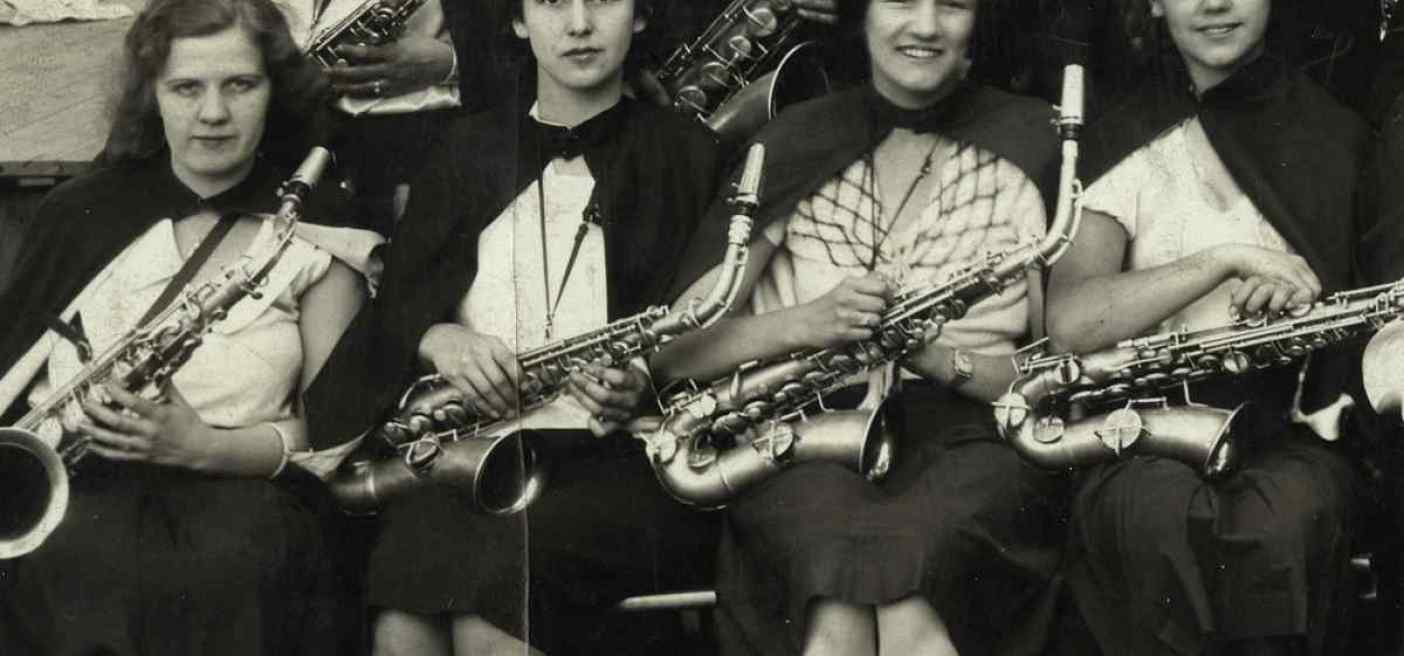
The Picture
In preparation for a History Speaks! talk that I gave in the summer of 2019, I was researching the history of the concert bands of Marathon County. Our archives and photo files contain dozens of examples of different bands from across the last 150 years or so, but one in particular stood out as unusual for its time: this picture of the members of the Ladies Saxophone Band with the Edgar Community Band.
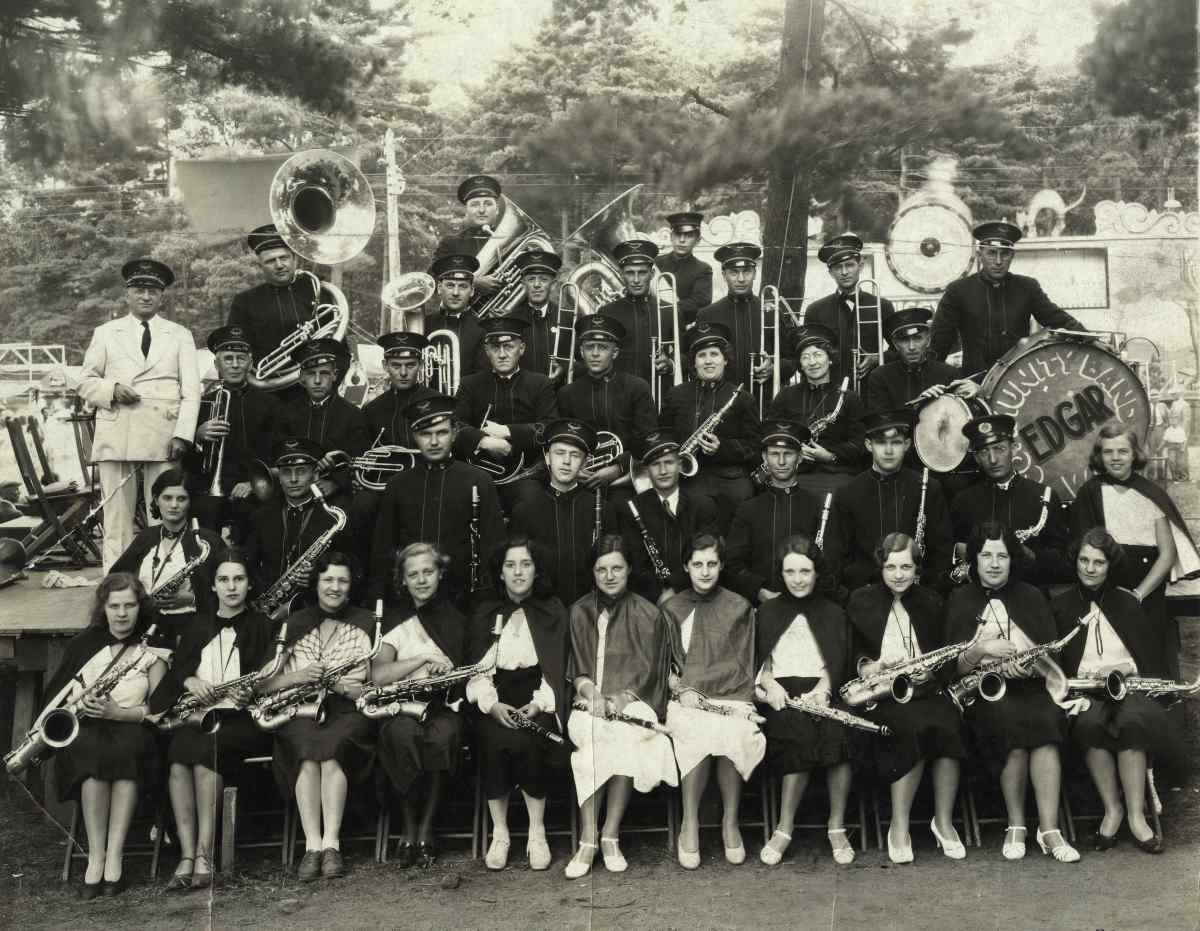
Unfortunately there is nothing written on the back or with other associated materials to tell us exactly where, when, and why this was taken. But I think this was taken in 1932 at the Wisconsin Valley Fair, where C.S. Cone (pictured in white on the left side of the stage) brought several of the bands he led to the Wausau fair. The picture was reprinted in the centennial history book, Edgar: An Illustrated History (1998) where the members of the Edgar Community Band were identified, but the female saxophonists in front were left unidentified because they were from Wausau.
And yet, if not for these ladies joining the Edgar Community Band to sit for this photograph, the Ladies' Saxophone Band may have been left in obscurity. But with the help of old newspaper articles and a little educated guesswork, we may be able to piece together part of their story.
The Band
In 1928, veteran bandleader and music teacher C. S. Cone took out ads in the local newspapers of Wausau and Edgar, looking for girls and ladies to join a new saxophone band. (He also tried to reached out to the Mosinee area in the hopes of starting a third group, but that did not work out). These advertsiements stated that prospective members did not necessarily need to have any prior experience as musicians or playing the saxophone, as Cone was more than capable of giving instruction. Although they hoped to attract 30 members to each group, they had 20 sign up in Wausau, and less in Edgar. But the groups were formed and it was hoped more ladies would join after the groups got off the ground.
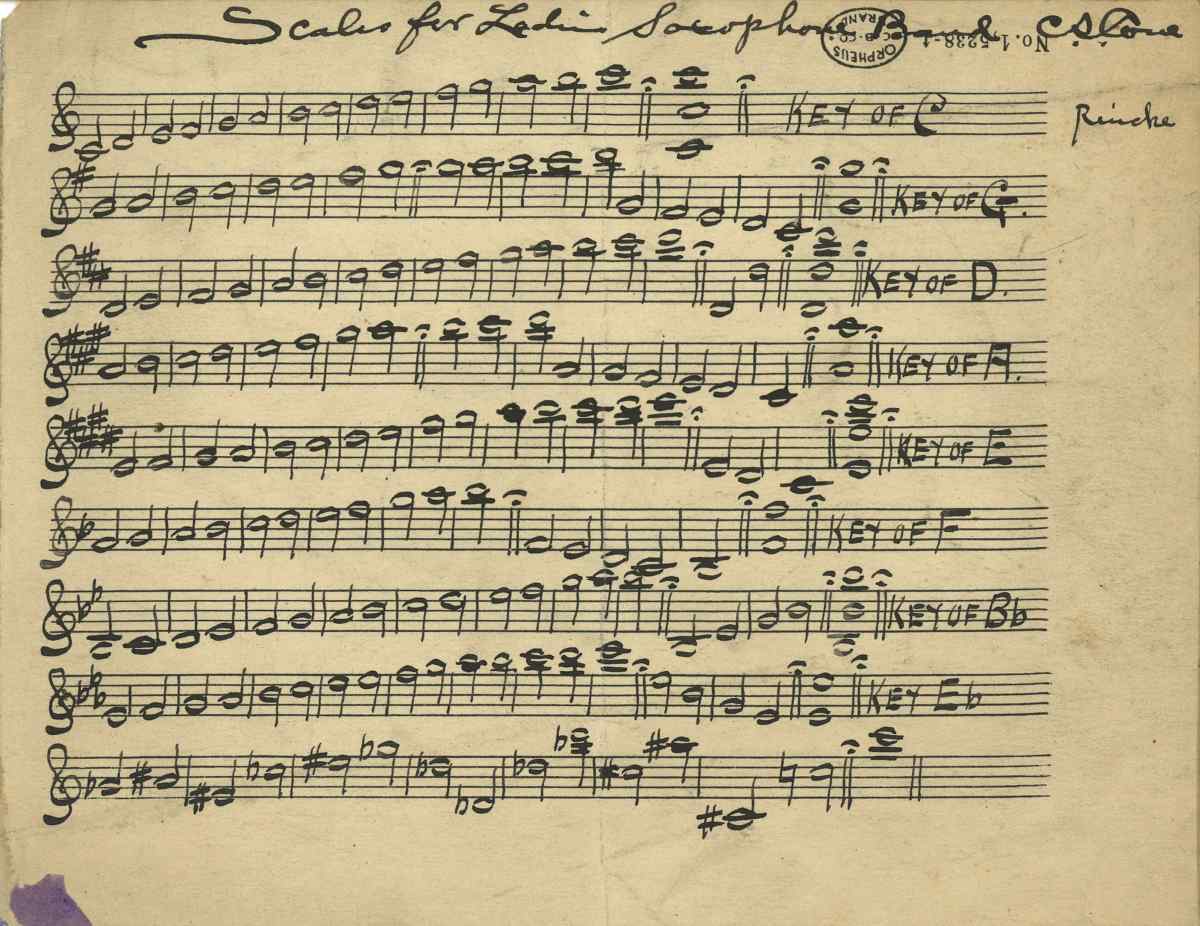
^ This is the only other material besides the 1932 photograph to reference the Ladies Saxophone Band in the MCHS archives. It is a single sheet of music from among C.S. Cone's papers, for the new saxophonists to practice their scales.
After a winter filled with rehearsals and instruction, the ladies started to perform for the public, usually with the Edgar and Wausau bands combined into a single ensemble.In January of 1929, they performed alongside a local production of the play, "The Eagle of the Sky" ("a comedy drama in three acts"), and throughout their first year of existence the Ladies Saxophone Band often played as a second attraction alongside plays and other spectacles.
The string of early performances often treated the ladies as a novelty. On advertisement boasted that this, "The First Ladies' Band North of Milwaukee," had only been playing for about three months, and asked audiences, "CAN THEY PLAY"? ... "You Be the JUDGE!"
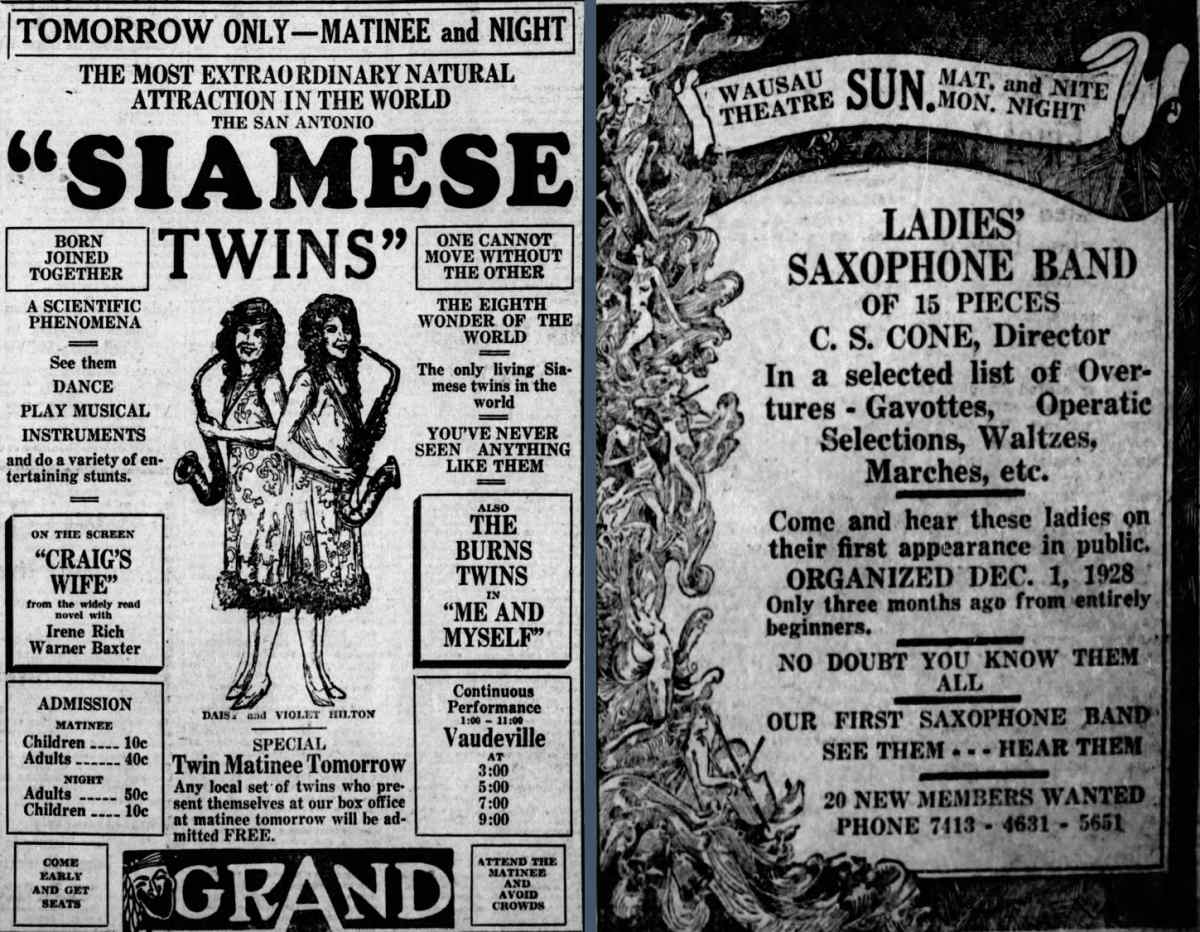
^ In early 1929, the Ladies Saxophone Band was booked as an attraction at the Wausau Theatre. But directly to the left of the notice was an ad for an act appearing that same weekend at the Grand Theatre featuring an appearance by the saxophone-playing Siamese twins Daisy and Violet Hilton. Both acts appealed to a sense of novelty with the use of female performers using the saxophone.
The Saxophone
C.S. Cone was one of the first bandleaders to experiment with the saxophone in the Wausau area. The earliest photograph to feature a saxophonist from Marathon County playing in a band (as far as I can find) was Cone's orchestra at the Grand Opera House in 1901.
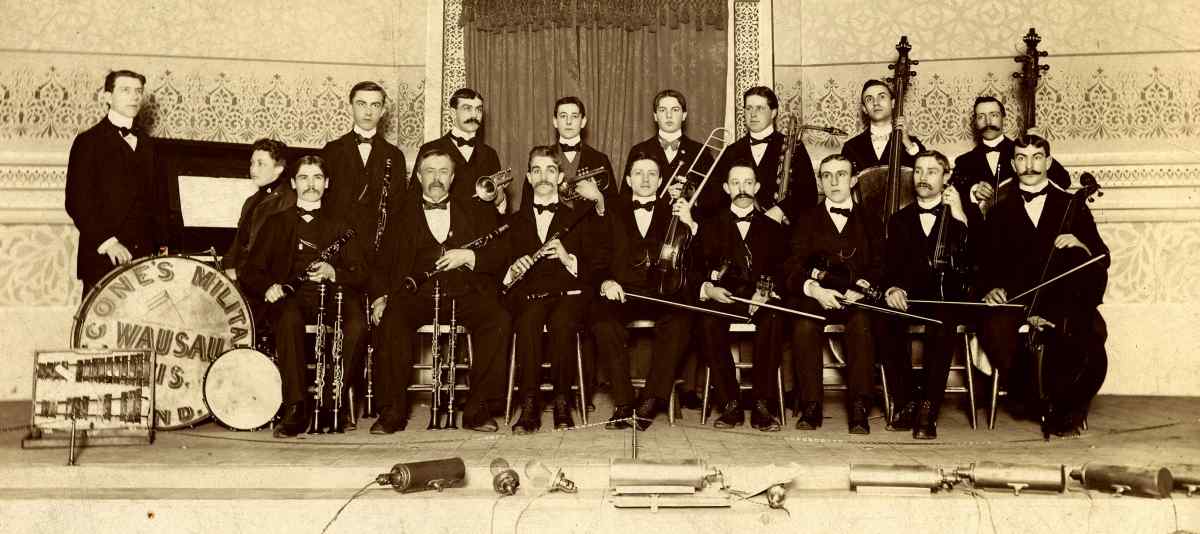
The saxophonist in question (standing in the back row, third from the right) was Ralph Baker, a cigar maker by trade. He appears to have picked up a baritone saxophone to cover some of the lower parts in the ensemble. By the end of the decade Cone had also integrated a few saxophones into his military-style band, but this was unusual for the musical groups at the time and most musicians had a hard time finding a place for the instrument in a serious, adult band.
Around the turn of the century, the European patents on the saxophone had expired and several American companies like Buescher and Conn started to produce their own versions of the instrument. And besides making some improvements in the design, they brought industrial production to mass produce (at least by the standards of the day) their saxophones. And by the 1910s, they were heavily marketing the new instrument to the public; particularly to students and young people.
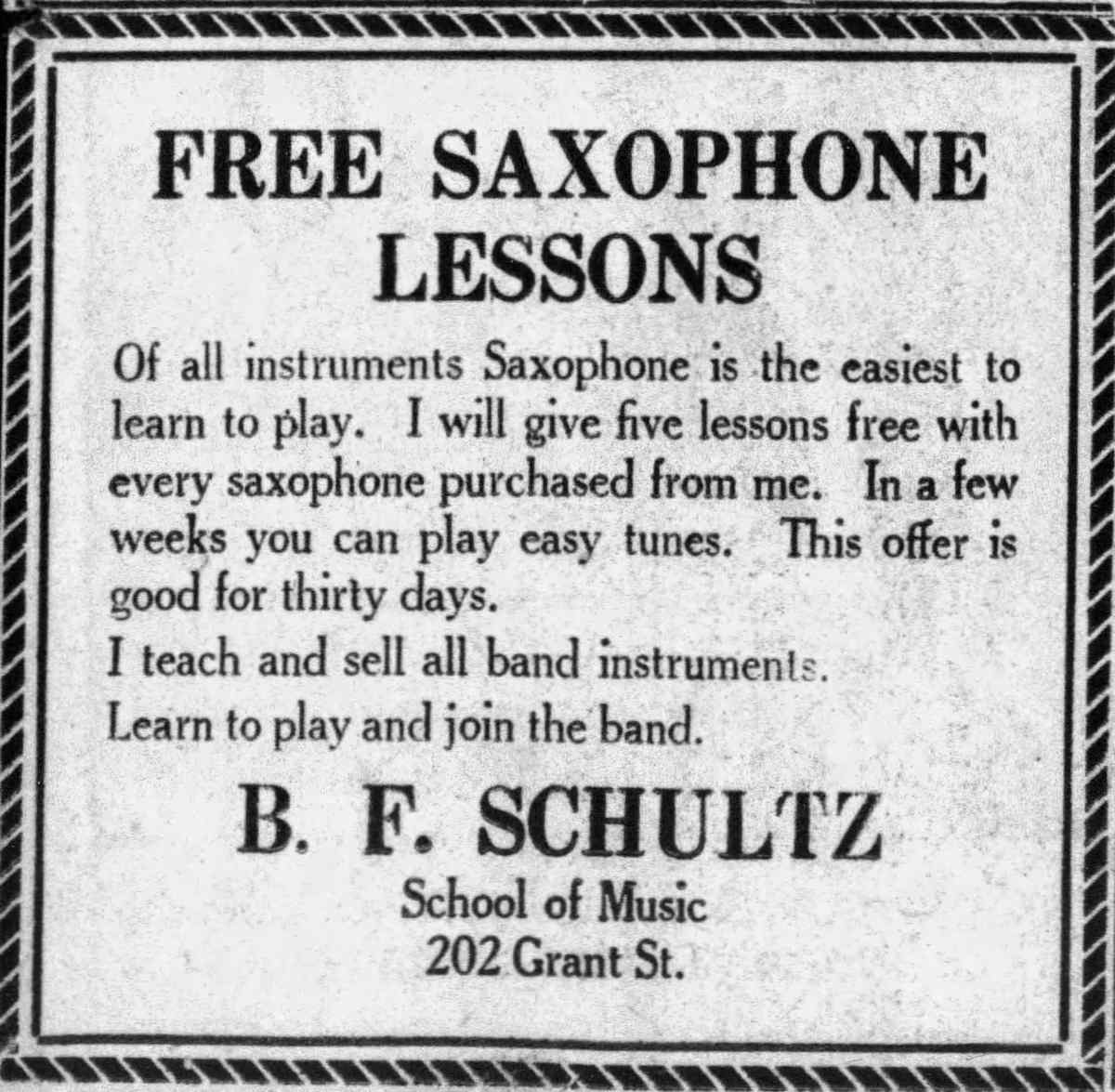
^ This advertisement for saxophone lessons ran in the newspaper in 1921. B.F. Schultz was another prominent figure in instrumental education of the twentieth century in Wausau, and though he was slower to embrace the saxophone in his own bands, he was happy to give lessons and sell instruments.
While this helped sped the new instrument across the country, beginning musicians picking up the saxophone did not necessary foster good will among those people within earshot of the squeaks and honks new players often produced. And while it is possible to play just about any instrument badly, most people had not heard the instrument being played well.
Within a few years, talented musicians would pick up the saxophone and impress the public with the heights one could take the instrument. Most of the popular saxophonists that emerged were from the new style being called jazz, but there were a handful of other saxophonists who proved the versatility of the saxophone in more "classical" settings as well.
Probably the most important of these non-jazz saxophonists was Rudy Wiedoeft. In the late 1910s, recordings of his virtuosic playing made Wiedoeft a household name, and he took his success (and his iconic C melody saxophone) on the road.
^ Wiedoeft's hit composition "Sax-o-phobia" as the closing number in a film short entitled Darn Tootin (1931). Uploaded to the youtube channel of Erik-Jan de With in 2015.
Wiedoeft's success led to national and international tours in the 1920s, which included stops in Wausau in 1922 and 1923. Wright's Music Store sponsored the concerts as part of a series featuring recording stars from Victor Records. These concerts included a variety of artists, including pianists, singers, and the odd comedian--but accounts of the performance in Wausau had highest praise for the featured saxophonist.
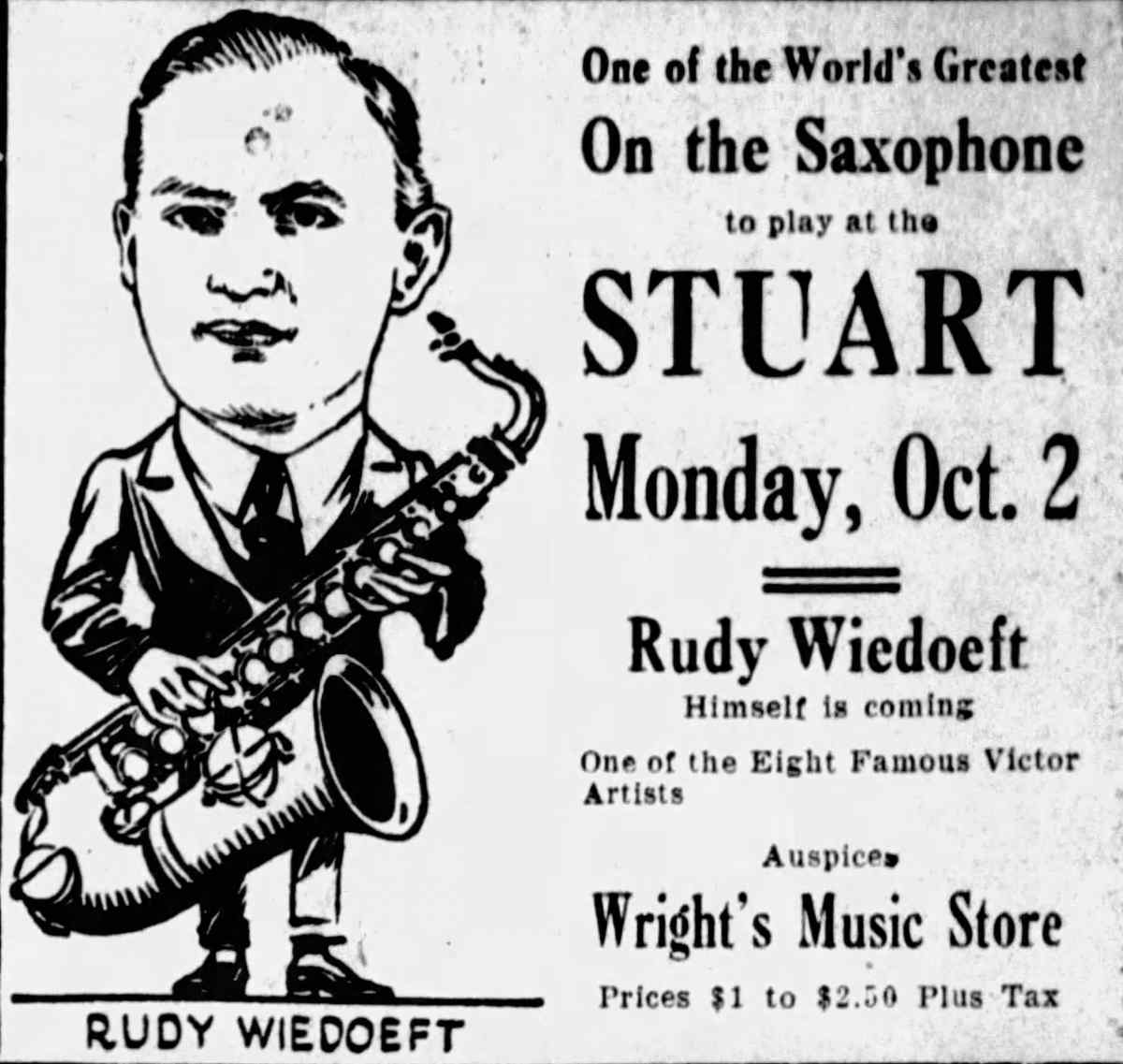
^ Ad from the Wausau Daily Herald for Wiedoeft's 1922 visit (22 Sept 1922).
"Rudy Wiedoeft was in a class by himself and is a saxophone artist. He had no competition and it is doubtful if he has an equal. He demonstrated the fact that something except jazz can be played on a saxophone as he played a number of difficult selections..."
-Wausau Daily Herald, October 3, 1922.
Wiedoeft's visit certainly helped raise the stature of the saxophone in the eyes of the public here in Marathon County. Shortly after his second visit in 1923, Wausau's leading musical group announced it would start its own, separate saxophone band. "Recognizing the popularity of the saxophone," an article announcing the change stated "members of the 128th Infantry Band have formed a saxophone band within that organization." It would be open to all members of the band who could produce a saxophone, regardless of what instrument they normally played (and actually it was stressed that anyone joining the larger band would need to play another instrument as the saxophone chairs were already filled).

^ Members of the 128th Infantry Band's saxophone section from 1928 (cropped from a full band picture) and an article from their brief time as a saxophone band in 1923 (from the Wausau Record Herald).
But despite a brief period of public interest in 1923, the novelty had worn off by 1924, and the brief experiment in the saxophone band ended in Wausau. And in general the idea of the saxophone band in the tradition of the older cornet-style bands (with the saxophone family replacing the brass instruments) looked like a trend that died in the 1920s.
This made it even more surprising when C.S. Cone's revived the format with a new generation of female musicians in 1929.
The Ladies
In many ways the Ladies Saxophone Band was a break from existing musical roles for women, who were traditionally limited in the ways they could participate in music performance. Almost without exception, the few women who performed music publicly were amateur singers, pianists, and occasionally string players.
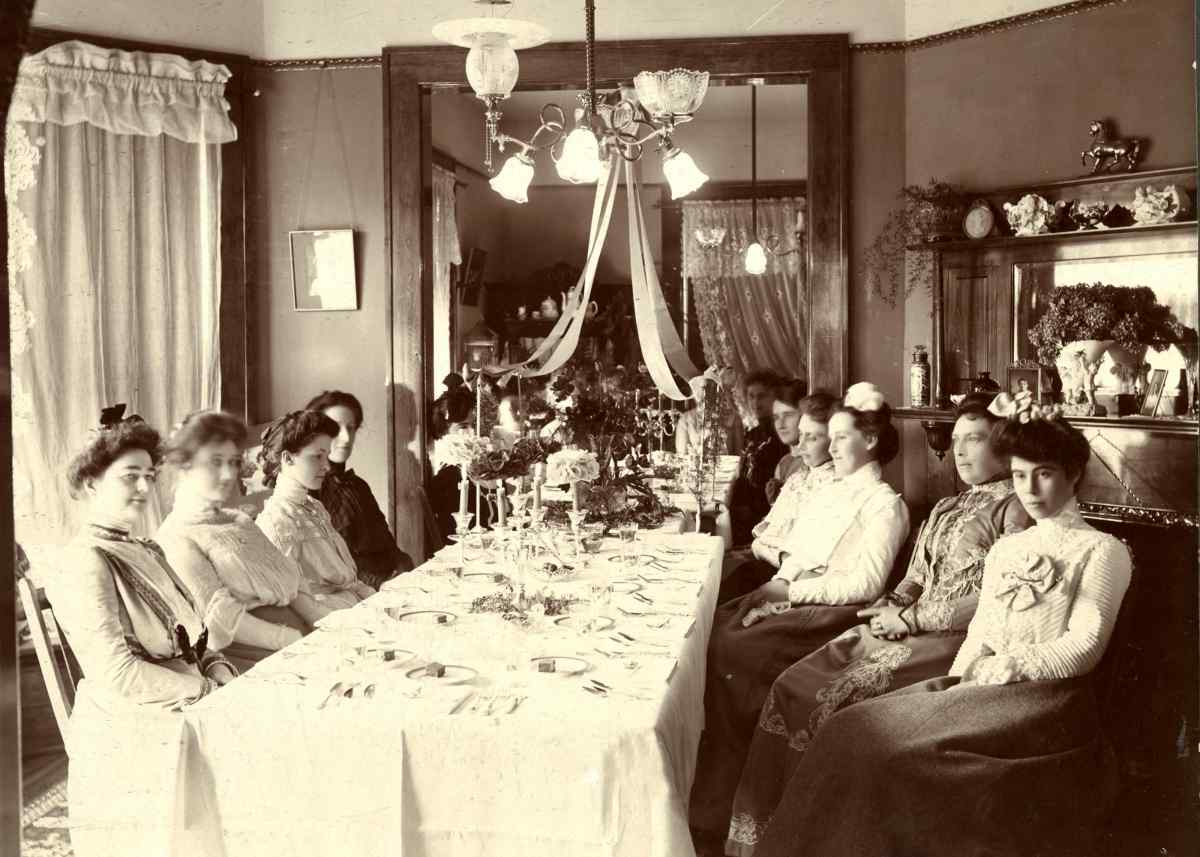
^ Members of the Tuesday Music Club, gathered in the dining room of one of their members.
The most prominent women's musical group of the day was the Tuesday Music Club. It was founded in 1896 by the women from affluent families in Wausau, and they regularly met to discuss, study, and perform music for each other. They also brought in experts and prominent performers to their meetings. Although their activities were often limited to the meeting of their own members, they also tried to instill of love of music across their community. For example this group of ladies funded public performances such as Balfe's "Bohemian Girl" in 1903 and helped to establish the Wausau Symphonic Orchestra in 1941.
The overwhelming majority their of the performances were vocal and on piano, with occasional string instruments. Our archvies at MCHS include a box of programs, scrapbooks, and annual reports saved by the club over four decades, and only once is there an example of a brass or woodwind instrument being performed--and that was a flute player from the branch of the music club in Merrill. Granted this group was interested in the study of serious music as an academic exercise, and so we should not necessarily hold the lack of variety in instruments against them, but it does still show a clear bias towards what was deemed acceptable outlets for musical expression that did not include wind instruments.
That is not to say that women could not pick up a wind instrument on their own, and indeed in the early twentieth century it was not uncommon for gatherings of friends to feature amateur performances . And especially as school bands and orchestras were established in the 1920s, the access to the newer saxophone family--and the lack of clear gendered claims ono the new instrument--made it popular among young female musicians.
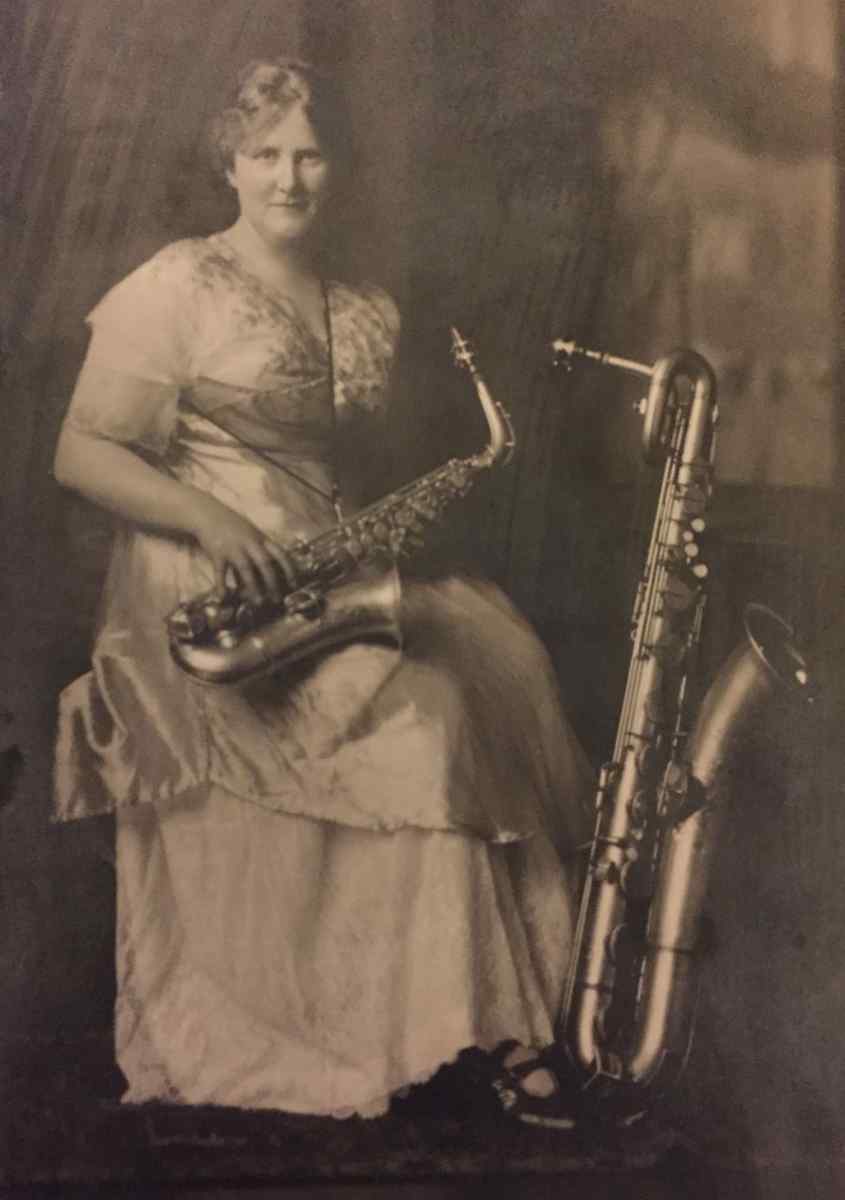
^ An unknown woman posing with her saxophones.
The formation of the Ladies Saxophone Band challenged these ideas for what was acceptable for ladies to play. While they started as something of a local novelty, within a few months they were traveling across the region for gigs, performing in their distinctive uniforms for many kinds of audiences.
"There were twenty-two ladies with uniforms consisting of red skirts, capes and tams and white blouses and they made a very pretty picture in the parade. They were greeted with applause all along the four mile march."
-WDH article on their appearance at an Eagles convention in Sheboygan, 19 June 1929
In the fall of 1929, they went north to play a series of dates, from an appearance at the Badger Theater and the State Theater in Merrill and Rhinelander respectively, a concert at Gleason's Universalist Church to benefit the local ladies guild, and down to Stevens Point to be broadcast by the WLBL radio station.
The Ladies Saxophone Band continued to play at various locations and for different groups across the next decade. Over a few months in 1930 alone, they were performed from the Kickbusch Grocery float as part of Wausau's Winter Frolic celebration, were brought in to entertain visitors for the jewelers convention, were featured performers at the Athens Fair, and provided music for numerous clubs and associations.
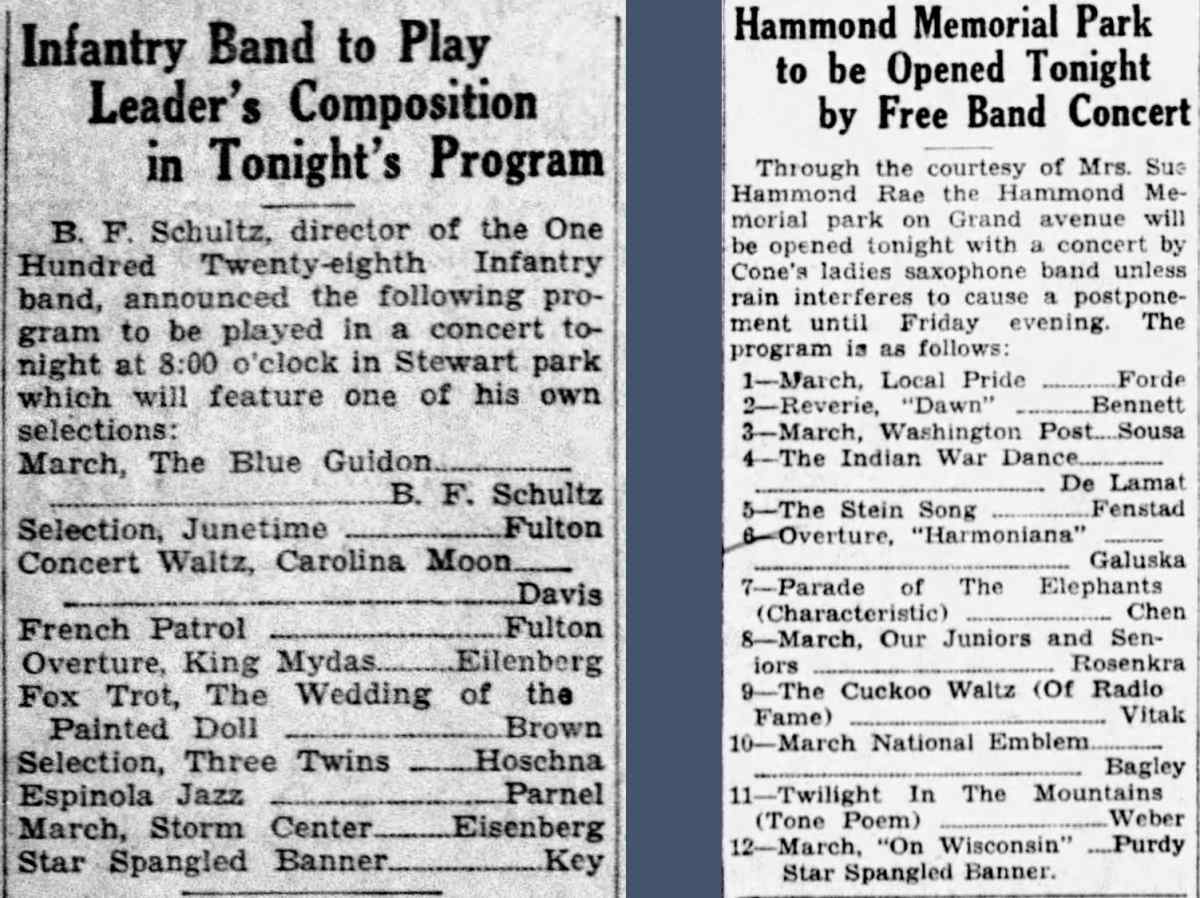
^ Articles giving the repertoire for concerts to be played by the 128th Infantry Band in 1929 (left) and the Ladies Saxophone Band (1930). This shows that the Ladies Saxophone Band played much the same repertoire as contemporary community bands, right down to the traditional closing with the Star Spangled Banner for a guaranteed standing ovation.
The Ladies Saxophone Band
Although we only know a handful of the ladies who made up the band over the years, they are representative of the new women coming of age in the 1920s and 1930s. They were young, unmarried, and had jobs as stenographers and secretaries at local businesses. They had benefited from the creation of formal band programs and the broader scope of musical education, as well as new attitudes towards the status of women in society.
But it appears as though the Ladies Saxophone Band had fallen apart by the end of 1935. The Edgar side of the group seems to have been dropped by 1931, and although the Wausau ladies continue to make appearances--notably as part of the annual concerts of the Wausau Liederkranz--their numbers had dwindled.
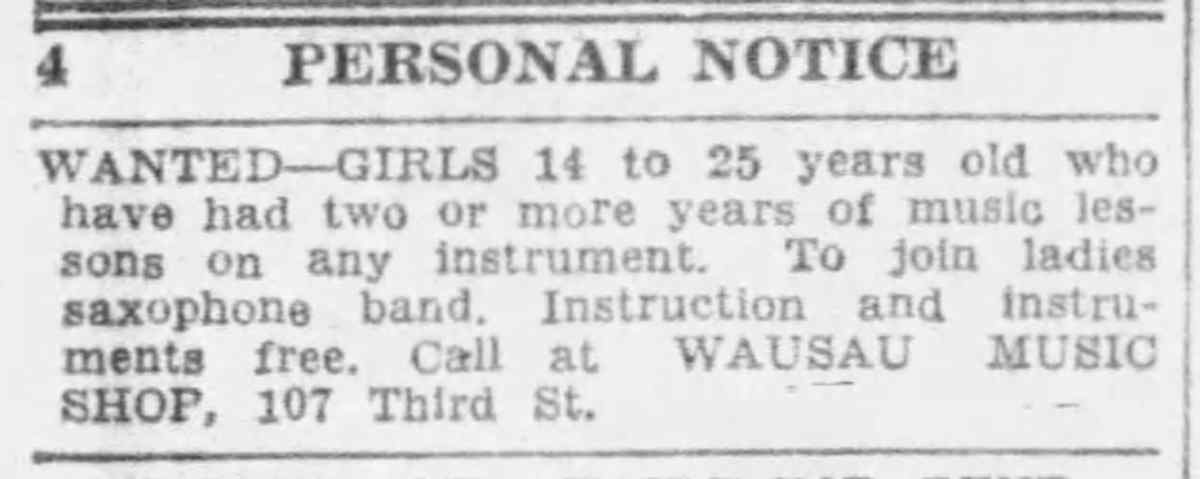
In 1935, advertisements once again were taken out in the newspaper looking for members, and Cone appealed to the common council of Wausau to request city funding as part of the concert season (he explicitly asked for half the money allocated per concert of the 128th Infantry Band at the time). But in the end, the time of the Ladies Saxophone Bands came to an close.
Perhaps there is more information out there, or someone has a photograph or red cape stuffed away in a closet (and if so, please let us know!). But if not for that fateful decision to include the female saxophonists with the Edgar Community Band in 1932, the Ladies Saxophone Band may well have disappeared completely from the historical record.

